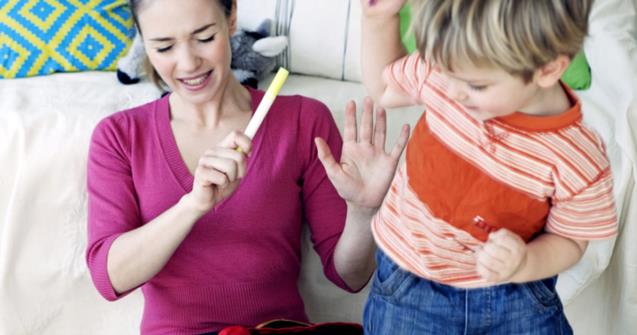
The hyperactive child
First of all, I chose to write about this subject because I know that caregivers are often confronted with children with ADHD. In most cases, children are only diagnosed once they attend school, regardless of the fact that symptoms appear long before they reach seven years of age. Caregivers' daily observations can make it possible to detect symptoms which may be linked to this behavioural disorder and therefore allow for prompt action in order to help children and their parents learn to live with the disorder.
It is not always easy to share our daily life with a hyperactive child. They require a great deal of energy on our behalf and often, caregivers may feel as if none of their interventions are beneficial. Daily life is not easy for children with ADHD either. They are constantly under the impression that everything in their mind is moving and they are unable to explain their behaviour. Often, they act before thinking.
Here is a short list of a few symptoms which are commonly observed in hyperactive children. The presence of these symptoms does not necessarily mean that a child has ADHD, a professional opinion is essential. Their presence does however demonstrate that the child needs your help.
- He may have difficulty maintaining attention during projects or games.
- He most likely wanders from one activity to another.
- He is easily distracted by external stimuli.
- He often moves his hands and feet, squirms on his chair, has difficulty remaining seated for long periods of time (ex. lunch).
- He often runs and climbs around inappropriately.
- He often speaks too much.
- He has trouble waiting for his turn.
Interventions and activities
- I think the secret to success is congratulating children with ADHD. Frequently congratulating them may not solve the situation completely, but it can make children feel better. Try to notice when children do something well and immediately congratulate them. Congratulations may be verbal or you may simply make an affectionate gesture such as a tap on the shoulder, a wink, a high five, etc.
- When children do not follow instructions, choose logical consequences. They must be pertinent. You may encourage children to find consequences themselves. Make sure they are informed ahead of time. Try to give brief and precise instructions when necessary. If fewer instructions are given, it will be easier for children to remember them and they will be less inclined to disobey them. Ask yourself if your instructions are adapted to the age and capacities of the children under your care. Remember to establish visual contact with them to guarantee their comprehension. Use visual markers throughout your daycare as reminders: illustrations representing rules (in strategic locations), arrows, stickers, bright colours, etc.
- f a specific activity or action is prohibited, be sure to provide children with an alternative. This will avoid children feeling as if they aren't allowed to do anything. For example you could say, "I feel it is dangerous for you to throw rocks but I have a bag full of balls you may throw".
- Frequent positive experiences are important. Most children with ADHD have very low self-esteem. They are constantly faced with defeat and are often negatively judged by the people who surround them. Activities must correspond to their limits and capacities.
- Their daily schedule must be regular and predictable. Children must be warned ahead of time of any changes. For example, you may use a calendar to identify special outings or activities. Children with ADHD are destabilized by newness and they are unsure how to react.
- Schedule privileged moments with children throughout the day. Children with ADHD need plenty of attention. It is good to fulfill this need positively. Observe them and share their favourite activities.
- Use traffic lights to have children stop what they are doing. When children seem agitated, show them the yellow light. If their behaviour continues, display the red light. This indicates that they must sit down and relax in order to calm down. Display the green light when you feel they are ready to resume their activities.
- Set up a small corner where children with ADHD can go to be alone or to calm down. They may use the corner at your request or if they feel the need.
- When a special activity such as a field trip presents itself, talk about what is going to happen, the attitude you expect them to have, what is allowed and what is prohibited. This discussion can be done as a group. The use of illustrations or a guessing game can help.
- Hyperactive children have a great need for physical activity. Since they are faced with several limits throughout the day, recognize their need and provide an area where they can move about and let off steam safely. Provide a variety of material such as: jumping ball, bicycle, jumping rope, skateboard, etc. Show children the time frames in your daily schedule where they may be active.
Intervention strategies are countless!
Sonia Leclerc
No element of this text may be copied, reproduced, distributed, published, translated, downloaded, posted, or transmitted, in any way, without prior written authorization from Educatall and the copyright holder. Elements may be posted and/or downloaded solely for personal and non-commercial use provided no modifications are made and all notices of intellectual property are fully shown (name of the author, title of the article, name of the website, date the text is used and the date of the part in question).

 Home
Home Theme activities
Theme activities
 Babies and toddlers
Babies and toddlers
 Arts and crafts
Arts and crafts
 Science
Science
 Creative recipes
Creative recipes
 Tips and tricks
Tips and tricks
 Special needs
Special needs
 Extra activities
Extra activities
 Educ-TV
Educ-TV
 Newsletter
Newsletter  Online store
Online store Educatall club
Educatall club

